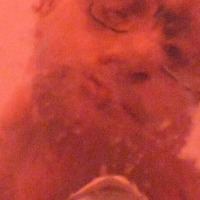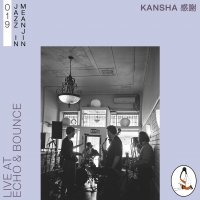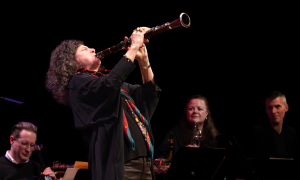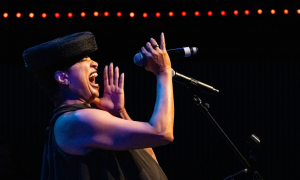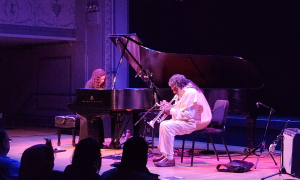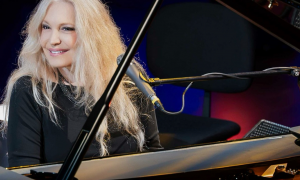Home » Jazz Articles » Live Review » Ostrava Days 2019
Ostrava Days 2019

Various Venues
Ostrava
Czech Republic
August 22-31, 2019
The biennial Ostrava Days festival rolled around again, and there's nothing quite like a once-every-two-years event to make time appear to flow even faster than normal. As a moderne composition festival, it is difficult to accurately fix its stylistic placement, although there are returning concerns with free improvisation, electronics, minimalism, vocal music, performance art, marathon presentations and site-specific events. We could say that the chief attitudinal guiding figures of Ostrava Days include John Cage, Karlheinz Stockhausen, Morton Feldman, Frederic Rzewski, perhaps Steve Reich and Philip Glass, but now Julius Eastman.
Much of the music enjoys a relationship with ceremony, chance, repetition and quietness, or alternatively drone, abstraction, sparseness and suspension. The players, the students, the audience, all intuitively grasp where Ostrava Days rests its confused head, and everyone is there, communing with new and experimental music, occasionally casting back to a hoary old classic, though often those oldies have retained their life-spark of revolutionary attack, often over multiple decades.
There is very much a New York City transplanted to the Czech Republic feel, as many of the composers involved dwell there, and many of the players, particularly the soloists are imported from Gotham. Not least the Ostrava Days artistic director Petr Kotík, who divides his time between these cities. Equally, though, there are many Czech composers and players involved, as well as a multitude of involved folks from other lands, particularly around Europe, but often Asia and beyond. The opening night of Ostrava Days once again took place at the Brickhouse, Hlubina Coal Mine, in an area that has grown in artiness over the last two years. There's a whole new frontal café in place now, with its own outdoor terrace.
The first night was divided into two parts, The Past and The Coming. Ensemble OD2019 performed works by Terry Riley and Robert Ashley in the first half, selecting the former's most famed innovation, "In C," from 1964, but "The Wolfman," by the latter, is one of its composer's less familiar early works, again from 1964.
Zach Layton, for many years a pivotal force at NYC's Issue Project Room, was imported to lead "In C," playing electric bass and leading the gradual transitions. He's well-accustomed to this role, adopting the same position when (le) Poisson Rouge hosts the annual interpretation of Riley's minimalism-founding classic. James Ilgenfritz handled the upright bass, and the line-up also included drums, piano and singers, the gang getting straight into a pronounced pulse. As with the (l)PR performances, a rock aura prevailed, which lends the work a rougher attack, given that most versions usually stem from a classical ensemble foundation, although at times there were suggestions of what Michael Nyman might have created under these circumstances. This was a grand pomp strut reading, getting steadily heavier, though the acoustics of the room weren't kind to the rock drumming bombast, which became too dominant, and too regimented.
The Finnish singer/performer Juho Laitinen was central to the Ashley piece, which was something of a revelation if the listener was well versed in the majority of what came to be known as his signature style in subsequent decades. Hard environmental noise scurfed up an unscalable wall (James Falzone on electronics), as Laitinen vocalised wordlessly (or so it sounded), clad in a (plastic?) boiler suit and protective goggles, lighting dimmed to obscure even further. The visual aspect was almost important as the assaulting sonics. It was a curious learning, but ultimately not preferable to Ashley's later language.
Members of the Ostrava New Orchestra joined for The Coming, which included more (and shorter) works, largely penned by 2019 residents of the festival's Institute, whose daytime activities were busy with preparations and rehearsals. The opening numbers laid down the gauntlet emphatically. These were parts of the "Black Series," by the Austrian composer Peter Ablinger, calling for a spread that included paired drumkits, three electric guitars and a harpist/singer. We were about to rock! A whiteout introduction paused, then returned, vampirically sucking our collective breath, as we counted the classical pussies in the audience, with their fingers plunged deep into their virgin ears. Heavy on the cymbal ssszzzsss already, a magnified tape hiss took over, for nostalgia reasons, as this mighty cassette recreation combo brought out the mallets for another climax. Fingers remained in ears even for these hiss sections, would we believe? Then the elements got broken up, crumbled into iron man filings. Ablinger would return later in the festival, to impress again.
But there were still seven more composers to come! Next up, Viacheslav Kyrylov's solo piano piece "Softly Say Goodbye" had a self-important device of using precious silences, ad nauseum, with extremely extended pauses between any pool of activity. This was an unfortunate post-Ablinger placement.
M.O. Abbott's "Ascension Tube" had percussion, electric guitar, throaty bass clarinet, and splintered piano, conducted by Kotík, making groaning sweeps, with a low, mordant booming progression and studied pauses, the percussion ranging from faint glasses down to resonant kettle drums. Another fine piece was "To Home" by Noemi Savková, dominated by Miklos Holló's cimbalom, with an underlying woodblock stutter, French horn pomp, triangle punctuations and angular piano stabs. Tubular bells completed this attractively varied palette, along with a singing violin and some cello unity.
Only one day into the festival, and we were plunged straight into The Long Night, which was a marathon in the extreme sense, beginning at 5pm on the Friday and extending without pause until noon on the Saturday. That was approximately 1,080 minutes. This was a stupendous highlight of Ostrava Days, even if it was surely a near physical impossibility to catch all of its performances. Even if a human being had slid matchsticks into eyeballs, something would have given by the early hours of Saturday morning. Even a music nerd has to snatch beauty sleep.
Right at the start, on the square, just outside the Jiří Myron Theatre, where most of the marathon action was to transpire, in different rooms, there was a performance of Dieter Schnebel's "Harley Davidson." A pack of bikers converged on the area just in front of the Cathedral Of The Divine Saviour (which would also host subsequent performances during Ostrava Days). They came from slightly afield, as the principle local Harley-Davidson chapter of Ostrava were apparently not too keen on taking directions from a conductor. These nine bikers (the same number as the Nazgûl dark riders in The Lord Of The Rings) clearly spent time cultivating their bearing, choosing the metallic-gleam colours of their hogs, sniffing out matching leathers, saddlebags, bandannas and t-shirts (one rider sported a Motörhead model). They rode in, revving, and trundled into formation, issuing engine coughs that possessed a powerfully percussive quality. Conductor Steffi Weismann cued simultaneous throttle actions, sequenced in a line, as well as prompting the switching on and off of headlights, the swivels of handlebars, the parping of horns, to nestle alongside the conversation between trumpet and keyboards of the Ostravská Banda. The bikers were incredibly sensitive, clearly completely attuned to the purring of their beasts. As the revvers roared, the piece climaxed as the riders moved off, circling calmly around the Cathedral forecourt. Composer Schnebel had died only a few months before this latest realisation of his work, but these engines live on forevermore. This was a full carbon emission classic from the year 2000!
Soon afterwards, in the theatre foyer, four pianos were lined up for "Crazy Nigger," the ground-breaking 1979 work by New York composer Julius Eastman. In recent years, his legacy has been virtually rediscovered, and Eastman sometimes offers a sidelong variation on the makings of minimalism. Eastman was also a co-founder of the SEM Ensemble, along with Petr Kotík. This group began in 1970, and is still very active today. Eastman's compositions are appearing in concert programmes with increasing regularity in recent years, on both sides of the Atlantic. The pianos of Joseph Kubera, Daan Vanderwalle, Alexandr Starý and Miroslav Beinhauer took turns in their level of cascading attack, making periodic circular surges. The rifflets faltered, rested, then drove off again, with a particularly sensitive form of latticed hammering. Together, it was as though the pianos took on the quality of a gigantic collective zither or qanun, forming tolling groups of two or three, as small groups of guest performers slowly gathered around behind the players, during the final 15 minutes, contributing to the cascading as they bent over the limited key-space. Your scribe shouldn't have told you about this later development, as the climactic massing caused a peculiar shock of gradually coalescing surprise.
Moving fully inside the theatre, a Hungarian cimbalom theme developed, with three works penned to highlight this hammered dulcimer-like instrument. A new work, "Stringed," by the Dutch composer Klaas de Vries, was performed with the cimbalom to the side of a string quartet. Subtle and spare at first, and hardly employing the cimbalom's innate folkish qualities, it fired up around halfway, as player Jan Rokyta hit harder to increase vibration resonances dramatically, coordinated with the group string flurries.
In the smaller room, 12, Daniel Skála played Alois Hába's 1960 "Suite For Cimbalom," using three sets of spatulas on one instrument, for maximum subtlety and sensitivity of expression. Then he was joined by Malgorzata Hlawsa (flute) and Juho Laitinen (cello), for "Psy" by the Hungarian composer Peter Eötvös, which was much more studied and formal in comparison to the personalised Hába suite.
After solo cimbalom, we could thrill to solo accordion, when Žaneta Vítová played the German composer Alexander Held's "Perpetual Motion," breathing, wheezing, making bellow movements but issuing no actual held notes, then keys fingered with no bellows action, with micro-expression in her tiny touches. Vítová had a forceful performing personality manifested via small movements.
Ablinger returned close to 10pm, this time with a work for cello and electronics, snappily titled "In G Cello & Electronics." It opened and closed with electronic floods, Matthias Lorenz's cello barely audible. Then the too-long main middle mass involved those four strings being touched exceedingly faintly, which was presumably a deliberate strategy. The 'tape hiss' also appeared to be intended. Lorenz's gestures were more visible than their results being audible: had we suddenly gone deaf following Ablinger's noise- fest on the previous evening?
After 11pm, the Ostrava New Orchestra performed La Monte Young's 1960 "Composition 1960 #7" (how do composers imagine these titles?). Your scribe usually digs his pioneering minimalism, but this early work involved a good deal of one dimensional tone tedium, its too-subtle ebbs and flows making a steady progression, as twinned instruments entered, then left.
This scribe slept for the night, following a few more works from Petr Kotík, Elliott Sharp and Robert Ashley. This involved skipping extended pieces by Alvin Curran and Morton Feldman, although pleasingly, the latter's "For Philip Guston" was still evolving after breakfast, even though beginning at 6.30am. This was sensitively explored in the theatre foyer by the core manifestation of the SEM Ensemble, with Kotík (flute), Kubera (piano) and Chris Nappi (percussion), whose marimba, glockenspiel and tubular bells mushroomed the palette, as the three followed (or invented) a communal rhythm flow which was jointly dependent, sprouting from each other's contributions, and often implied within the listener's perception. Several folks were still arrayed on the ground, perhaps fully asleep, perhaps dreaming, perhaps semi-lucid, as the implied continuum was discovered at luxurious length, prompting genuinely altered listening states until around 11.30am.
The waking climax involved a short stroll outside, to the Miloš Sýkora Bridge, for a 'round noon premiere of "Super-Ostrawitza," by resident institute composer (from London) Theo Finkel, making a confident, extravagant statement beyond his years, with players positioned on both banks of the Ostravice River, on the bridge itself, and closer to the gathered audience. The piece was specially penned with the morning conclusion of The Long Night in mind. Finkel had created and arranged an extremely disintegrated version of a street band, separated by extreme distances, and divested of their parading tendencies. Lone sounds, or sometimes small group clusters threw themselves across the river, or surprised the audience from behind, the vast span of the performing area acting as a natural mixing desk, according to the innate loudness of a horn, or the bent ear of a listener.
After the post-marathon brunch, and the discussions that ensued, there wasn't too much time before that Saturday's Minimarathon Of Electronic Music struck up, situated in another mine, not yet discovered by attendees of this and the 2017 Ostrava Days. This marathon was only set to span a mere six hours, and its definition of electronic music was broad, encompassing certain performers of an acoustic bent, prepared to have their organic matter modified in this or that way. The Michal coal mine of this once ore- crazy city began its existence in 1843 and closed in 1993, now operating as a museum. The music was presented in the 'chain dressing room,' which was hung with grisly-looking instruments of deep digging. This bunker zone was usefully sensitised to some of the unruly, grinding and gripping sonics that revealed themselves in three groupings.
The Austrian trio Sarros used turntables and two laptops, exposing crackles, pops and birdsong, with found snatches of environmental material, very sparsely negotiated. Agnes Hvizdalek sang solo, and her electronics weren't visible, and didn't seem to be controlled by herself, or any assistant. It seemed as though this Austrian was employing a set effect that she knew very well, anticipating its delays and fracturing. She vocalised high, sustaining, then breaking up, processed with increasing extremity (or so it sounded). Hvizdalek purred underwater, with distressed feline glottalisms, surely not something she could create with a throat alone, a pure, unaltered vocal chute. It was best not to know about the techniques used, better to simply marvel at these highly unlikely voice acrobatics. Jonáš Gruska, contrastingly, made his music very visual, completely revealing, nay displaying, his means via a rotating loudspeaker sculpture. This Slovakian crouched, with laptop and gear in a plastic case, the self-constructed sonic horns casting their sounds around the cavernous walls with a hearty echo effect. Gruska made sonics reminiscent of clacked woodblocks and insectoid leg-rubbing, as well as utilising what seemed like a heavily sculpted piano source.
The second grouping started with Muddersten, another trio, this time a Scandinavian mixture, using tuba, prepared guitar and percussive objects-with-contact- microphones. A record rotated, small chimes and whines circled the depth-charge tuba of Martin Taxt, bowed metal rods made suspended tones and drones, whilst curt crunch- events increased the activity, and the band began to sound like that Norwegian supergroup Supersilent. Next, the Russian synthesist Kurt Liedwart built up a wall of oppression, comprised of tones and rumble, as a pulsing thrum grew, chittering spurts of sub-bass defecation vibrating our wooden chairs, developing into warm shimmers. Angélica Castelló (a Mexican in Vienna) surprised by appearing above, on a risky-looking ledge, with reduced visibility. Her noise distortions were suffused with agitated heavy breathing, splashed by cave-water sonics, levering up to full-on crescendo, but not exactly rife with electroacoustic ideas.
An absolute highlight of the entire festival was the 'headlining' Poisonous Frequencies trio of Petr Vrba (trumpet), Tomáš Procházka (guitar) and Didi Kern (drums), who'd invited Swiss turntablist Joke Lanz to guest in their improvisations. Lanz came across as a permanent member rather than a fleeting acquaintance, so in tune was he with the Frequencies. Lanz snatched up scattered vinyl, making savage fader cuts with quicksilver resourcefulness, as Procházka forced out primitivist riffs and Vrba graduated from electronic twiddling to jazzed trumpet, suddenly shifting the axis. He jammed a saxophone mouthpiece onto his horn, heralding a complete distorto break-up on guitar, as Kern's mono-beat repeating made this the heaviest free improvisation heard for many moons. It was Vrba himself who assembled the roster for this gripping afternoon-and-early-evening feast.
In typically restrained fashion, Sunday offered only one concert, the Orchestra Opening at the voluminous Triple Hall Karolina. A smaller part of this space was sectioned off, turned into a slightly more intimate zone for the Ostrava New Orchestra. Even though this was a single concert, it was still divided into three parts.
This festival's Canadian regular Marc Sabat ensured a serene, suspended orchestral quality for "The Luminiferous Aether," as lush blooms were slit by flashes of lightning through the upper glass, and perhaps thunder, or was that the kettle drums? The harp stood slightly outside of the stream, like a subliminal soloist, sounding askew, in a microtonal manner. Petr Cígler's "Horn Concerto" was a world premiere, with Ondřej Vrabec's French horn prompting the spiky, dynamic action, with woodblock prominence and a condensed structure that called to mind the work of Edgard Varèse. Then, James Layton's "Focal" seemed like an interlude in the wake of the first two works. Pianist Daan Vandewalle soloed in another world premiere, "Movis," by Michal Rataj. The sparse piano, along with cajon taps and rumbles, created the dynamics of a rock band introduction, the string ranks making brief swells, bows used to tap percussively. The horns were accentuated, and the 'breathing' percussion awakened, as Vandewalle perpetually embellished, although it was the orchestral writing that ultimately magnetised the attention.
Following the first intermission, the Israeli Chaya Czernowin's 37 minute "Guardian" had thickly citrusy string strafes, with brief bulletpoints from the horns and percussion. The spotlit Séverine Ballon's cello made friction flurries, and a traffic cone was used to mute the tuba, glasses of water adding to the percussion section. The cello became even more rousingly abrasive, sounding hard, but articulated with sensitivity.
Another break preceded "DW28 Loops For Davis," by the Austrian composer Bernhard Lang, with a mini-band of synthesiser, sampler, bass and percussion out front, and Gareth L. Davis as bass clarinet soloist. This immediately imparted a jazz character, as Davis called to mind the honeyed throatiness of John Surman. An introduction led to the strings weighing in with a controlled cacophony of jumble, with a Steve Martland/Mark-Anthony Turnage orientation. The electronicists uncaged their crowd- vocal samples, and the percussionists magnified their high metal content, strings making a sliding, careening motion, with conductor Johannes Kalitzke calling on some of the swiftest baton work around.
On the Monday eve, once again at Karolina, the smaller Ostravská Banda performed a shorter sequence of works. Institute resident Daniel Lo's "Poids" was a highlight, bringing on tension through near-silence, until a kettle drum erupted, releasing the brooding anticipation. A lyrical brightness appeared, with tiny string frissons glowing porous. The work was inspired by the huge installation of the same name by the French artist Louise Bourgeois. The world premiere of Christian Wolff's "Small Orchestra Piece" was conducted by Petr Kotík. Wolff is another composer who is central to the Ostrava Days ideals, and continues to write and perform with vigour, emanating great sprightliness at 85 years of age. Nothing untoward transpired until around ten minutes in to the 25 minute piece, when a series of percussion punctuations roused the strings, awakening into a sweeping, sonorous theme. Kotík unexpectedly picked up his flute, eloquently conversing with the ranks. Isabel Mundry's "Endless Sediments" made imaginative use of the impressive percussion sprawl, with tiny metal objects, shakers, careful wood-details, a gong array and cymbals spinning on the tables, as the strings fluttered restlessly.
Back to the Brickhouse, at the Hlubina Coal Mine, where two programmes of music lay in waiting, the first at 6.30pm, followed by an 8.30pm return. Five works were presented in a From Vienna sequence, performed by the large Studio Dan group, which was formed in 2005 by trombonist Daniel Riegler-Beer. They are regulars at the Porgy & Bess jazz club in Vienna.
The serpentine tones of Jee Won Kim's "Who Am I?" involved a smaller gathering of violin, flute, clarinet and cello, but "In The Summer Every Truth Is Like A Saturday," by the notable New York bassman James Ilgenfritz drew on a broader spread for its world premiere. Saxophone, trombone, flute, strings, piano, drumkit and trumpet emanated a composed improvisation aura. This composition was inspired by Rahsaan Roland Kirk. Spurts of engine room stick-thunder cut to a piano solo, and joint trills erupted, swirling, hyperventilating spins, almost dancefloor orientated. Ilgenfritz corralled a robust splicing of musical vocabularies, with scampering horns, playful strings, a muted trumpet solo, charging drums and an outbreak of distorto keyboards. This was easily one of the festival's most confidently articulated and excitingly style-leaping works.
It was synthesiser, electric bass, trombone, saxophone and drums for Christoph Walder's "Vozmozhnost" short spurt. Twitchy, lumbering rhythms matched jazz with rock, after Frank Zappa, as a slurred, drunken slow sway, in seven minutes of highly compacted activity. Again, when only a short amount of time is allotted, the music gets ultra-compressed. Following Walder's seven, Mirela Ivičević had eight minutes to languish in, so "The F Song" seemingly enjoyed a movement per minute.
The last work was "Wow And Flutter," by Oxana Omelchuk, featuring doubled trombones for its skeletal funk workin,' contributing to a bathyspheric bounce, with a bass synth headbang, slithering serpent belly abrasion and those drawlin' 'bones. A sluggish grind had intermittent flute and bass clarinet parts, rubbed snare drum and bell releases, concluding with a New Orleans jazz funeral march. Tom Waits down the mine shaft!
The second part of the Wednesday night concentrated on works that spotlit the piano, with a particular focus on two members of the mighty Musica Elettronica Viva, a group who were active in Rome and beyond from 1966 into the future. These reunited buddies were Alvin Curran and Frederic Rzewski, the latter playing piano on Kotík's 1964 piece "Spontano," penned behind the Iron Curtain. Kotík originally wrote it specifically for Rzewski. Delicate openings led to isolated bursts, a pair of tubas making siren signals, prompt punctuations preceding heavy silences. Rzewski's own 2015 work, "Satires," was performed by Daan Vandewalle (piano) and Conrad Harris (violin), its gypsy emanations arriving from Hungary, quite possibly. A scampering motion was implied, but in reality there was a potent space in its silent stretches.
Following a short intermission Rzewski presented a new piece, "6 Movements," which sounded like it could well have been an MEV improvisation, or at least an outburst of free expression, subsequently notated. Such is the luxury of a performer exhibiting his own work. Rzewski ran off with extra rapidity, eager to enter the sonic fray, having no truck with new music formality. A commanding flow took over, with giant steps then tiny filigrees, potent pauses, a dynamic looseness with a luminescent sensitivity. Just to break (or maybe increase) the audience's attention, he growled and expostulated, interrupting his own piano flow, like a leviathan Cecil Taylor, romantic, flamboyant, and playing with an alternative energy, sprung from derailing spontaneity.
Curran possessed a similar confidence of carrying on regardless of expectations. His "Shofar Rags" could also have been invented in the moment, sounding quite similar to his NYC performance in March 2018, at the Park Avenue Armory. Similar, yet these connected pieces also sounded like different manifestations of the same concept. Opening on standard acoustic piano, Curran soon picked up the ancient Jewish ram's horn which gives this work its title, blowing it inside the open lid, bathing in its heavy echo. He picked out piercing notes to target the cerebellum, and then graduated to his sampling synthesiser, increasing the sonic ballast for full electronic ruination.
On the festival's second Friday, Ostravská Banda gave their second concert at Karolina, playing five substantial works, with one intermission. Miroslav Srnka's "Eighteen Agents" called for 19 string players to be arranged in almost a full circle, scaling up to a sustained plateau. A cello provided small solo flourishes, while the higher strings careened as if gusted by strong gales. The composition exuded a joyful exuberance, in a rare new piece that sounded optimistic, as its climactic thickening became manic in nature. High vibrations permeated "Punctuated Equilibrium," by resident institute student James Falzone, this world premiere conducted by Kotík. Clarinet and trumpet joined with the shimmering vibraphone resonances, as a chiming riff accumulated its strength, marked by percussion punctuations. Car horn sounds cycled around "Found Objects," by another resident, Matt Simon, with violin, cello and finally bass making serrated flurries, this procedure continuing, then pausing. Clarinet came to dominate, with decelerated string figures, quieting down, before the entire piece was gently sucked down the plughole.
A pair of longer works followed the intermission, by the hyper-established old guard of Ostrava Days. Kotík gave the global premiere of "Wednesdays At RW On Spring Street," for a larger ensemble, penned especially for the violin soloist Hana Kotková. Accordion, flute and bass leaned forward from within the sparse drifting, then a fanfare sprung up, with other horns joining the flute. Finally, in this 20 minute piece, the full string spread and tempestuous percussion followed another key violin solo, tubular bells tolling while it's in progress. For Rzewski's 2014 Franz Kafka-inspired "A Dog's Life," the ensemble expanded even more,with percussion augmented, this time by metal cans. Halting calls exposed the Karolina hall's extreme reverb, but this supported the composition, as the players worked with the walls rather than banging against them, the effect sounding deliberate. Daan Vandewalle's piano seemed somehow separate, as with the Rataj piece from a few days earlier. He worked through its patterns with a diligent expressivity. A slumbering beast gently awoke, as the full ensemble resumed, with their glimmering drama and romance, in the old school manner. Somewhat surprising for a Rzewski piece. Vandewalle flicked the keys, then brushed them in near silence, before eventually reactivating his 'normal' touch, incrementally building up banging, bassy blocks. The pianists have their unpredictable moods! The final stretch of this 30 minute odyssey was very different, with a melancholy music box-ed piano, a pair of rainsticks and some surprise group whistling from the players.
On the festival's concluding day, the institute residents had the opportunity to summarise their time spent in Ostrava, by presenting a Last Call afternoon concert of new works at the Janáček Conservatory. The general mood was one of chamber music conventions being gleefully perverted into fresh forms, whether successful or not. The South Korean composer Leo Chang's "Respond To Troy: Variation" used laptop, guitar, accordion and alto saxophone, making ghost whorls that gathered their mass, making a sudden stop, then the growing resuming into a soft blizzard. The Troy in the title is the avenue in Crown Heights, Brooklyn. Near darkness descended for "Almost Touching," by Kim Farris-Manning, with a video backdrop of a squiggle taking a walk. As Martin Škubal sang and played guitar, what's best described as necrotic bossa nova took control, sent through his attached throat microphone, as acoustic string phrase fragments shaped a shadow of a song, as if delivered by an unwell troubadour. Periodic tones were suspended with, many might say, excruciating silences, like a sleeping breath, during "A Particular Window." Edgars Rubenis (from Latvia) had crafted ideal meditation music for flute, clarinet, violin and cello, as the listener was encouraged to phase into other realms. The most striking work was "Aposynthesy," which Iranian composer Amin Sharifi had scored to sound like a freely improvised piece, with a well-selected spread of accordion, electric guitar, bass clarinet and trombone, full of breath hisses and bassy strikes.
The climactic Saturday evening concert of Ostrava Days involved the Prague Radio Symphony Orchestra performing "Neither," written by Morton Feldman in 1977, and incorporating words by Samuel Beckett. It's nearly an hour long, and involved a crucial input of staging, which intensified the lingering encroachment of music, words and movement. Although supposedly an opera work, Feldman had navigated away from most of the form's conventions, with the vocal contributions of Claudia Barainsky weaving subtly inside and outside of the orchestral shimmering, maintaining a restrained mood that built up a strange sort of soft tension. The Beckettian characters of Estragon and Vladimir took a slow walk from Waiting For Godot, each of them making a painfully slow and impeded progress along wooden walkways, eventually aiming to traverse the entire large stage spread. Meanwhile, the shaven-headed Barainsky ascended to a suspended boat, where she delivered Beckett's minimalist pronouncements. Sadly, it was later discovered that the singer was wearing a skull-cap rather than being genuinely sheared, but this didn't detract overly from the performance. As expected from Feldman, this was set to be a darkly developing glide along a grim river, effectively drawing out an atmosphere to be savoured, as each graduation and process evolved.
Photograph: Martin Popelar
Tags
Live Reviews
Martin Longley
Czechia
Prague
John Cage
Karlheinz Stockhausen
Frederic Rzewski
Steve Reich
Philip Glass
Terry Riley
James Ilgenfritz
Michael Nyman
Elliott Sharp
Alvin Curran
Supersilent
Edgard Varèse
John Surman
Rahsaan Roland Kirk
Frank Zappa
Cecil Taylor
PREVIOUS / NEXT
Support All About Jazz
 All About Jazz has been a pillar of jazz since 1995, championing it as an art form and, more importantly, supporting the musicians who make it. Our enduring commitment has made "AAJ" one of the most culturally important websites of its kind, read by hundreds of thousands of fans, musicians and industry figures every month.
All About Jazz has been a pillar of jazz since 1995, championing it as an art form and, more importantly, supporting the musicians who make it. Our enduring commitment has made "AAJ" one of the most culturally important websites of its kind, read by hundreds of thousands of fans, musicians and industry figures every month.

